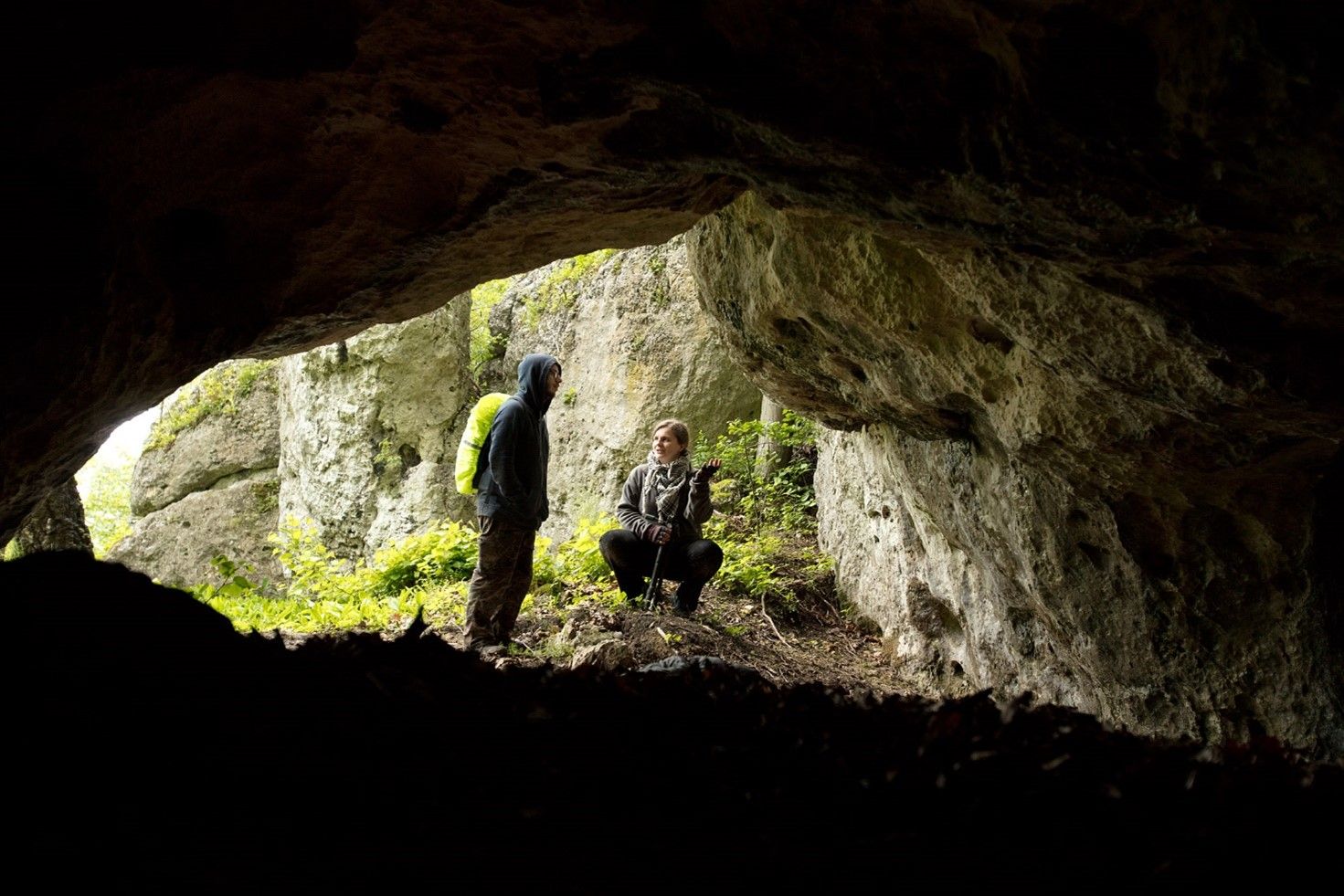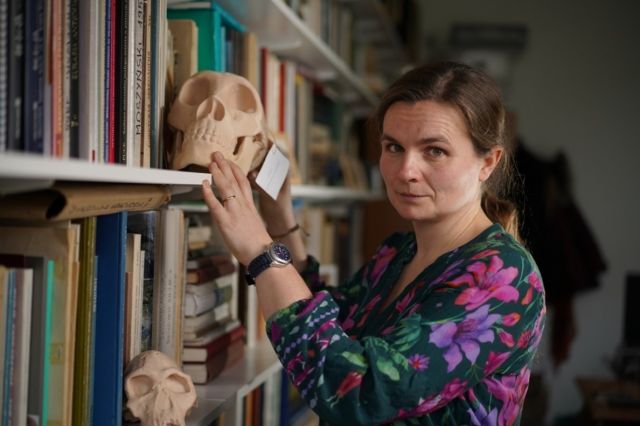Principal Investigator
:
dr hab. Małgorzata Kot, prof. UW
University of Warsaw
Panel: HS3
Funding scheme
: SONATA BIS 6
announced on
15 June 2016
Caves are places that have attracted people since the dawn of time. They provide shelter from the rain, wind, and scorching sun. They also provide a sense of security. They allow you to hide in the face of danger or hide something important and valuable, making it easy to return to it later. In a word, caves are ideal archaeological sites. Over thousands of years, they have accumulated traces of human presence and activity, and thanks to the specific and highly stable conditions inside, many of these traces are preserved much better than in open areas.
 Collecting modern bird pellets for a comparative collection in Koziarnia Cave, Photo: Miron Bogacki
This is probably why caves have been of interest to archaeologists for decades. One of them was Waldemar Chmielewski, who in the 1960s and 1970s explored a total of 13 caves within just one valley located in the Jura Ojcowska called the Sąspowska Valley. However, he never studied or published the results of his research. As part of the SONATA BIS project, I formed an interdisciplinary research team to study the results of an archaeological excavations of the caves of the Sąspowska Valley. We analysed artefacts found in the mid-20th century and conducted additional excavations in 6 caves to collect samples for further laboratory analysis. The findings from our research exceeded our highest expectations.
Collecting modern bird pellets for a comparative collection in Koziarnia Cave, Photo: Miron Bogacki
This is probably why caves have been of interest to archaeologists for decades. One of them was Waldemar Chmielewski, who in the 1960s and 1970s explored a total of 13 caves within just one valley located in the Jura Ojcowska called the Sąspowska Valley. However, he never studied or published the results of his research. As part of the SONATA BIS project, I formed an interdisciplinary research team to study the results of an archaeological excavations of the caves of the Sąspowska Valley. We analysed artefacts found in the mid-20th century and conducted additional excavations in 6 caves to collect samples for further laboratory analysis. The findings from our research exceeded our highest expectations.
As a result of our research, we discovered traces of the oldest human settlement on the territory of Poland, 450-600 thousand years old, in the Tunel Wielki Cave. The artefacts found were made by the hand of homo heidelbergensis – an ancestor of the Neanderthal.
We discovered the earliest traces of a Gravettian camp in this region, dating back around 30,000 years. These mammoth hunters, known mainly for the famous Venus of Willendorf and dwellings built from mammoth bones, rarely ventured north of the Carpathian Mountains. In the Koziarnia Cave we found flint inserts of their hunting weapons.
We discovered the only known Mesolithic hunter's campsite located in a cave – specifically in the Bramka Rock Shelter. What made them set up camp in a rock shelter? Most likely, it was the proximity of flint, which they used to make their tools.
We also analysed the remains of a child buried in the Tunel Wielki Cave. The girl, buried with a finch skull in her mouth, most likely arrived in our lands in the mid-17th century during the Swedish Deluge. The findings of genetic analyses indicate that she came from the north.
 Archaeologist Prof. Małgorzata Kot and palaeontologist Prof. Claudio Berto at the entrance to the Tunel Wielki Cave. Photo: Miron Bogacki
Based on radiocarbon dating, we were able to identify a previously unknown phenomenon of depositing human remains in caves by communities during the Roman Period and the Migration Period. We observed a similar phenomenon in the Late Bronze Age and the Early Iron Age. Both of these periods are interesting because the local population practiced cremation rites at the time, placing the remains of the deceased in clay urns and burying them in cemeteries located in open-air sites. In contrast, the remains found in caves are uncremated. In this respect, our findings can be considered preliminary, as they now only allow us to raise new questions, such as who were the dead buried in the caves, did they belong to local communities? Are the bones found evidence of burials or other previously unrecorded rituals? To answer these and many other questions, we will need to continue analysing additional cave sites.
Archaeologist Prof. Małgorzata Kot and palaeontologist Prof. Claudio Berto at the entrance to the Tunel Wielki Cave. Photo: Miron Bogacki
Based on radiocarbon dating, we were able to identify a previously unknown phenomenon of depositing human remains in caves by communities during the Roman Period and the Migration Period. We observed a similar phenomenon in the Late Bronze Age and the Early Iron Age. Both of these periods are interesting because the local population practiced cremation rites at the time, placing the remains of the deceased in clay urns and burying them in cemeteries located in open-air sites. In contrast, the remains found in caves are uncremated. In this respect, our findings can be considered preliminary, as they now only allow us to raise new questions, such as who were the dead buried in the caves, did they belong to local communities? Are the bones found evidence of burials or other previously unrecorded rituals? To answer these and many other questions, we will need to continue analysing additional cave sites.
Even this brief overview of our findings shows that our project covered an exceptionally broad chronological range – from the Lower Palaeolithic to the 19th century. What tied it together was, on the one hand, the Sąspowska Valley located in the heart of the Ojców National Park and the history of its settlement over millennia, and on the other, the methodological approach to the analysed materials. This is because we decided to approach all artefacts with equal attention, regardless of their age, which was particularly challenging because the uppermost layers of cave sediments are often highly disturbed, and the artefacts found within them are rarely accompanied by features such as hearths. An example of this is the aforementioned human bones, found without a burial context, among numerous artefacts and animal bones of various chronological backgrounds, with the result that each bone must be treated as a separate find. However, thanks to the tools available in modern science, it is now possible to carry out numerous analyses that make it possible to reconstruct, at least partially, the original context of such finds. In the project, we placed a strong emphasis on finding methods to answer as many of the questions as possible through the materials analysed.
Due to the wide chronological range of the studied artefacts, the project is of particular significance for archaeology. Indeed, it provides a starting point for further research and new questions thanks to the discovery of a number of phenomena previously unrecorded by archaeologists.
For me personally, the project was an extraordinary scientific adventure that gave me the opportunity to work with a group of remarkable researchers. The experience of managing a large interdisciplinary research team facilitated me develop and secure an ERC Consolidator Grant for the study of high-altitude cave sites in Uzbekistan.
Project title: : The history of cave settlement in the Sąspowska Valley from the Palaeolithic to the modern era in the light of unpublished sources from the excavations of Prof. Waldemar Chmielewski
dr hab. Małgorzata Kot, prof. UW
Malgorzata Kot – archaeologist. She is fascinated by the world of Neanderthals and their relationship with Denisovans and modern humans. She conducts research in Poland and in the western Tien Shan and the Pamir-Alay ranges of Central Asia. More recently, she has been focusing her interests on cave sites, which hold far more interesting stories than just the mysteries of the last Neanderthals. She teaches at the Faculty of Archaeology of the University of Warsaw.


